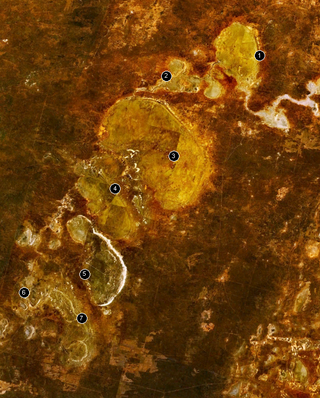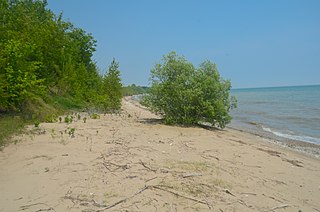Related Research Articles

Monte Verde is a Paleolithic archaeological site in the Llanquihue Province in southern Chile, located near Puerto Montt, Los Lagos Region. It contains two separate layers, the younger Monte Verde II, dating to 14,500 cal BP, and an older, much more controversial layer suggested to date to 18,500 cal BP. The Monte Verde II site has been considered key evidence showing that the human settlement of the Americas pre-dates the Clovis culture by roughly 1,000 years. This contradicts the previously accepted "Clovis first" model which holds that settlement of the Americas began after 13,500 cal BP. The Monte Verde findings were initially dismissed by most of the scientific community, but the evidence then became more accepted in archaeological circles.

The Upper Paleolithic is the third and last subdivision of the Paleolithic or Old Stone Age. Very broadly, it dates to between 50,000 and 12,000 years ago, according to some theories coinciding with the appearance of behavioral modernity in early modern humans, until the advent of the Neolithic Revolution and agriculture.
The Huelmo–Mascardi Cold Reversal (HMCR) is a cooling event in South America between 11,400 and 10,200 14C years BP. This cooling began about 550 years before the Younger Dryas cooling in the Northern Hemisphere, and both periods ended at about the same time.

The Willandra Lakes Region is a World Heritage Site in the Murray region of New South Wales, Australia. The Willandra Lakes Region is the traditional meeting place of the Muthi Muthi, Ngiyampaa and Barkinji Aboriginal tribes. The 240,000-hectare (590,000-acre) area was inscribed on the World Heritage List at the 5th Session of the World Heritage Committee in 1981.

Lake Mungo is a dry lake located in New South Wales, Australia. It is about 760 km due west of Sydney and 90 km north-east of Mildura. The lake is the central feature of Mungo National Park, and is one of seventeen lakes in the World Heritage listed Willandra Lakes Region. Many important archaeological findings have been made at the lake, most significantly the discovery of the remains of Mungo Man, the oldest human remains found in Australia, Mungo Woman, the oldest human remains in the world to be ritually cremated and as the location of the Lake Mungo geomagnetic excursion, the first convincing evidence that Geomagnetic excursions are a geomagnetic phenomenon rather than sedimentological.
Australian archaeology is a large sub-field in the discipline of archaeology. Archaeology in Australia takes four main forms: Aboriginal archaeology, historical archaeology, maritime archaeology and the archaeology of the contemporary past. Bridging these sub-disciplines is the important concept of cultural heritage management, which encompasses Aboriginal and Torres Strait Islander sites, historical sites, and maritime sites.

Two Creeks Buried Forest State Natural Area is a site in the Wisconsin State Natural Areas Program and a unit of the Ice Age National Scientific Reserve. The site lies in the northeast corner of Manitowoc County on the shore of Lake Michigan north of Two Creeks, Wisconsin, USA. Periodically exposed in a steep lakeshore bluff is a stratum of sediment, known as the Two Creeks forest bed. It contains stumps, logs, branches, pine needles, pinecones, moss, and other forest litter and is sandwiched between layers of glacial till. This is an important site in Great Lakes geochronology because it firmly establishes the timeframe of advances and retreats during the last glacial period in this region.

The Paisley Caves or the Paisley Five Mile Point Caves complex is a system of eight caves in an arid, desolate region of south-central Oregon, United States north of the present-day city of Paisley, Oregon. The caves are located in the Summer Lake basin at 4,520 feet (1,380 m) elevation and face west, carved into a ridge of Miocene and Pliocene era basalts mixed with soft volcanic tuffs and breccias by Pleistocene-era waves from Summer Lake. One of the caves may contain archaeological evidence of the oldest definitively-dated human presence in North America. The site was first studied by Luther Cressman in the 1930s.
Bluefish Caves is an archaeological site in Yukon, Canada, located 54 km (34 mi) southwest of the Vuntut Gwichin community of Old Crow. It has been controversially suggested that human occupation radiocarbon dates to 24,000 years Before Present (BP) based on radiocarbon dating of animal remains, but these dates are contested due to the uncertain stratigraphic context of the archaeological remains relative to the dated animal remains. There are three small caves in the area.

Cueva Fell or Fell'sCave is a natural cave and archaeological site in southern Patagonia. Cueva Fell is in proximity to the Pali Aike Crater, another significant archaeological site. Cueva Fell combined with the nearby Pali Aike site have been submitted to UNESCO as a possible World Heritage Site.
Yuchanyan is an early Neolithic cave site in Dao County (Daoxian), Hunan, China. The site yielded sherds of ceramic vessels and other artifacts which were dated by analysis of charcoal and bone collagen, giving a date range of 17,500 to 18,300 years old for the pottery. The pottery specimens may be the oldest known examples of pottery.
The Coats–Hines–Litchy site is a paleontological site located in Williamson County, Tennessee, in the Southeastern United States. The site was formerly believed to be archaeological, and identified as one of only a very few locations in Eastern North America containing evidence of Paleoindian hunting of late Pleistocene proboscideans. Excavations at the site have yielded portions of four mastodon skeletons, including portions of one previously described as being in direct association with Paleoindian stone tools. The results of excavations have been published in Tennessee Conservationist, and the scholarly journals Current Research in the Pleistocene, Tennessee Archaeology, and Quaternary Science Reviews. The site was listed on the National Register of Historic Places on July 12, 2011.
The Lake Mungo remains are three prominent sets of human remains that are possibly Aboriginal Australian: Lake Mungo 1, Lake Mungo 3, and Lake Mungo 2 (LM2). Lake Mungo is in New South Wales, Australia, specifically the World Heritage listed Willandra Lakes Region.
Broken Mammoth, Alaska is an archeological site located in the Tanana River Valley, Alaska, in the United States. The site was occupied approximately 11,000 to 12,000 years ago making this one of the oldest known sites in Alaska. Charles E. Holmes discovered the site in 1989 and investigation of the site began in 1990 and excavations are ongoing to this day.

The Kow Swamp archaeological site comprises a series of late Pleistocene burials within the lunette of the eastern rim of a former lake known as Kow Swamp. The site is 10 kilometres (6 mi) south-east of Cohuna in the central Murray River valley, in northern Victoria, at 35.953553°S 144.318123°E. The site is significant for archaeological excavations by Alan Thorne between 1968 and 1972 which recovered the partial skeletal remains of more than 22 individuals.
The Keilor archaeological site was among the first places to demonstrate the antiquity of Aboriginal occupation of Australia when a cranium, unearthed in 1940, was found to be nearly 15,000 years old. Subsequent investigations of Pleistocene alluvial terraces revealed hearths about 31,000 years BP, making Keilor one of the earliest sites of human habitation in Australia. Remains of megafauna suggest a possible association with Aboriginal hunting.

Aboriginal sites of Victoria form an important record of human occupation for probably more than 40,000 years. They may be identified from archaeological remains, historical and ethnographic information or continuing oral traditions and encompass places where rituals and ceremonies were performed, occupation sites where people ate, slept and carried out their day to day chores, and ephemeral evidence of people passing through the landscape, such as a discarded axe head or isolated artefact.
The Swan Point Archeological Site is located in eastern central Alaska, in the Tanana River watershed. It is one of a collection of sites in the area that have yielded the oldest evidence of human habitation in the state, in addition to megafauna no longer found in Alaska, such as wapiti (elk), bison, and woolly mammoth. Finds co-located with human artifacts at the site have given radiocarbon dates of 14,000 years, indicating the site was occupied around 12,000 BCE.
Tibitó is the second-oldest dated archaeological site on the Altiplano Cundiboyacense, Colombia. The rock shelter is located in the municipality Tocancipá, Cundinamarca, Colombia, in the northern part of the Bogotá savanna. At Tibitó, bone and stone tools and carbon have been found. Bones from Haplomastodon, Cuvieronius, Cerdocyon and white tailed deer from the deepest human trace containing layer of the site is carbon dated to be 11,740 ± 110 years old. The oldest dated sediments are lacustrine clays from an ancient Pleistocene lake.
The theory known as "Clovis First" was the predominant hypothesis among archaeologists in the second half of the 20th century to explain the peopling of the Americas. According to Clovis First, the people associated with the Clovis culture were the first inhabitants of the Americas. This hypothesis came to be challenged by ongoing studies that suggest pre-Clovis human occupation of the Americas. In 2011, following the excavation of an occupation site at Buttermilk Creek, Texas, a group of scientists identified the existence "of an occupation older than Clovis." At the site in Buttermilk, archaeologists discovered evidence of hunter-gatherer group living and the making of projectile spear points, blades, choppers, and other stone tools. The tools found were made from a local chert and could be dated back to as early as 15,000 years ago.
References
- ↑ Stone tool backdates evidence of human occupation, Landline, ABC Radio, Reporter: Tim Lee 12/08/2007
- ↑ Stone, Tim 2006 Last glacial cycle hydrological change at Lake Tyrrell, southeast Australia. Quaternary Research 66:176–181.
- ↑ Richards, Thomas, Christina Pavlides, Keryn Walshe, and Harry J. R. Webber 2007 Box Gully: new evidence for Aboriginal occupation of Australia south of the Murray River prior to the last glacial maximum. Archaeology in Oceania 42:1-11.